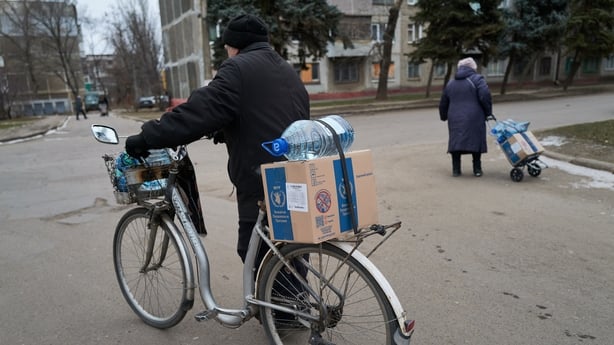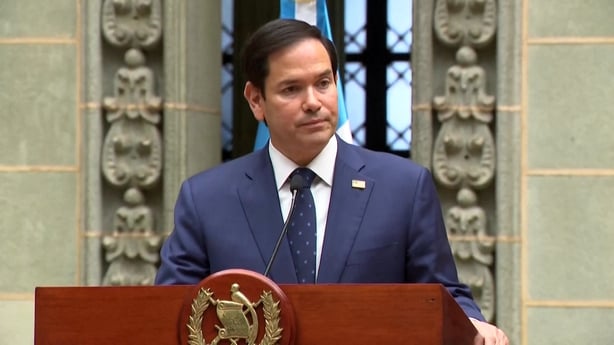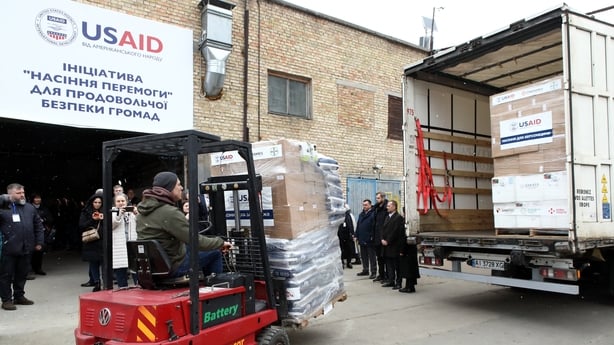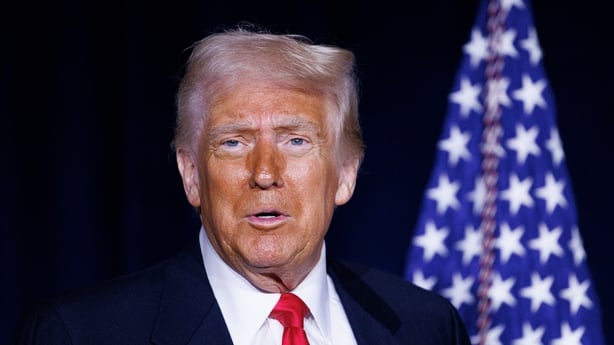The Trump administration's decision at the end of January to freeze billions of dollars in foreign aid from the US Agency for International Development (USAID) and US State Department was a shock to humanitarian agencies worldwide.
In Ukraine, a country that has received about $7.6bn in humanitarian aid and development assistance from USAID as well as State Department funding since the start of Russia's full-scale invasion, that shock has been felt too.
"It was completely unexpected. Of course, we heard the news, but it wasn't ever expected that it will be so massive and so immediate," Ivona Kostyna, chairperson of Veteran Hub, told RTÉ News from her office in Kyiv.
Veteran Hub provides support for Ukrainian war veterans and their families, including psychological support, and advice on how to find employment after army life. It runs centres in Vinnytsia, Kyiv and Dnipropetrovsk.

The charity does not disclose its annual funding budget but told RTÉ News that it received about two-thirds of its funding last year from the US State Department. That funding is now frozen for at least 90 days and it's unclear whether it will ever return.
Ms Kostyna's experience and that of the charity’s 100 staff members is similar to that of thousands of humanitarian workers around the world who worked with USAID and other US government aid agencies.
Upon hearing the sudden news on 24 January that their US funding would be frozen, the charity faced cutting 31 of its 100 staff roles.
The freezing of funds also meant that about 400 calls to Veteran Hub centres went unanswered during the last week of January.
"We received a post-factum stop work order so we had no space to rebuild and secure contracts that were supposed to last for longer periods," said Ms Kostyna.
"For us, it means we cannot answer calls to our clients. It means we cannot pay salaries to the people on our team, of whom we know have lost loved ones in battle".
Luckily for Veteran Hub, the local government in Vinnytsia and other donors have stepped in and guaranteed the charity’s staff salaries from 1 February for three months. That buys the charity time until the end of April but, after that date, the future of the charity’s work remains uncertain.

US President Donald Trump's executive order which introduced a 90-day freeze on all foreign aid has led to speculation that his administration will wind down the agency’s activities or subsume it into the State Department.
In 2023, the US government allocated more than $64bn to foreign aid. A good chunk of those funds could be cut during the new administration's current review.
Funding for essential food aid programmes remains unchanged by the new directive.
The USAID website has been frozen too. It features two paragraphs stating that, from 7 February, all USAID "direct hire personnel" are to be placed on administrative leave globally, with the exception of senior leadership. Some 10,000 people work for the agency.
It is a stark policy shift given that the US is the largest donor of aid in the world.
Last year, the US funded about 41% of all global humanitarian aid, according to the United Nations Office for the Coordination of Humanitarian Affairs.
At the same time, cutting foreign aid funding is in line with the Trump administration's 'America First' policy, a cornerstone of Mr Trump’s election campaign which pledges to prioritise domestic US interests.
Only three years ago, Marco Rubio was championing the work of USAID.
Now, as US Secretary of State, he's leading Mr Trump's charge to review the agency's work.

The funding freeze has also affected humanitarian organisations that receive US foreign aid in countries that border Ukraine, like Poland, which welcomed more than one million Ukrainian refugees after the start of Russia’s all-out invasion three years ago.
"From one day to the next we had to withdraw our staff from projects," a humanitarian official in Warsaw told RTÉ News.
"Our staff are concerned. We are often working with very vulnerable individuals. It has a detrimental effect on the mental health of individuals, pushing them into a more precarious situation".
USAID began working in Ukraine in the early 1990s, not long after the country declared independence from the Soviet Union.
The agency’s work in the country goes well beyond funding humanitarian aid projects. Of the $7.6bn allocated by USAID for Ukraine-based projects since February 2022, about $5bn went towards development assistance.
USAID has also facilitated about $30bn in US budgetary support for Ukraine during that time.
That money paid for the construction of bomb shelters, the salaries of staff working on development projects, covered local procurement costs and provided expertise on how to reform the energy sector, public governance and approach digitalisation.

Dmytro Boyarchuk, a Ukrainian economist, told RTÉ News that USAID has played a substantial role in supporting Ukraine’s agricultural and energy sectors since the start of Russia’s invasion.
"They purchased equipment for the agricultural sector to replace destroyed facilities. Farmers needed liquidity and the support from USAID was really crucial," said Mr Boyarchuk, who is the executive director of CASE, a Kyiv-based thinktank.
CASE has worked closely with USAID in recent years to implement economic reforms in Ukraine's public sector.
Without the agency's funding in future, Mr Boyarchuk said many local actors in Ukraine's development sector would need to change the way they operate.
Otherwise, he said, "they will not survive for sure".
USAID also funded independent media outlets in Ukraine to increase media plurality and combat Russian disinformation campaigns.
One of those is 'Ukrainer', a community-based media platform that publishes articles and videos about Ukrainian culture and history in multiple languages.
The platform's founder, Bohdan Logvynenko, said they never relied entirely on one donor but the freezing of USAID funding "has undoubtedly impacted our ability to plan long-term projects and sustain certain initiatives".

A couple of people I spoke to remarked on USAID's flexibility in terms of the kinds of projects it considered funding in Ukraine, compared to the European Union's more rigid funding procedures.
Innovative ideas like funding independent media outlets and providing grants for Ukrainian farmers to buy fertiliser played to the strengths of US soft power. But it is less in line with the Trump administration's worldview.
"President Trump stated clearly that the United States is no longer going to blindly dole out money with no return for the American people," read a press statement on Wednesday from Tammy Bruce, spokesperson for the US Department of State.
"Reviewing and realigning foreign assistance on behalf of hardworking taxpayers is not just the right thing to do, it is a moral imperative".
European Union funding could play a role in making up for some of the shortfall in lost USAID and other US foreign aid programs after the State Department completes its cost-cutting review.
Combined, the European Investment Bank's 'EU for Ukraine Fund' and EU humanitarian aid since the start of Russia's invasion amounts to about €2bn.
But the sudden freeze on funding has already pushed Ukrainian NGOs to scout around for new funding sources.
"We don't have the benefit of waiting for the US to decide on their policies," said Ms Kostyna, the chairperson of Veteran Hub.
"We must secure our services and now that the first crisis is over, we will start fundraising for more sustainable solutions."







